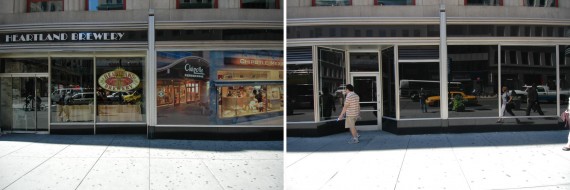Qatar now holds a 9.9 percent stake in Empire State Realty Trust, giving it a piece of the Empire State Building, an icon of the New York skyline. But while the office component of the property has had a renaissance over the past few years, nabbing tenants such as LinkedIn and Shutterstock, the retail remains a dud.
The 127,000-square-foot retail component, despite its prime location, has remained largely unchanged since ESRT went public in 2013. While other office complexes across the city, including the likes of One New York Plaza and 650 Madison Avenue, have revamped their retail to cash in on high rents and drive up the value of the office space upstairs, Empire State Building’s tenant list, which includes the Heartland Brewery, Walgreens and women’s fashion brand Bolton’s remain in place, some at well-below market rents, sources said.
Other brands such as Build-A-Bear, Men’s Wearhouse, Perfumania and Bank of America have left, leaving the property with a slew of empty storefronts along the 34th Street corridor. New retailers who’ve inked deals have had mixed success. While a new Starbucks and Chipotle are always packed with tourists and office workers, STATE Grill and Bar, a restaurant concept originally imagined by chef Octavio Becerra, is sparsely attended, sources said.
“You have to ask why the bank [B of A] made the move,” said Faith Hope Consolo of Douglas Elliman. “ You would think that, as long as you’re on the corridor, what does it matter? But they made the move, so there’s an issue.”
She added: “The food in the Empire State Building hasn’t changed with the shifting of the times.”
A spokesperson for ESRT did not respond to a request for comment, nor did CBRE, the retail leasing broker for the building.
Industry insiders said Empire State Building becoming part of the REIT may have hurt the building’s retail prospects, since public companies have to deal with stringent regulatory requirements that can be a burden to tenants.
“They can be really hard to make a deal with,” said one retail broker who recently dealt with the company. “Their security [deposit] requirements are very onerous. If you’re doing a deal with a local mom-and-pop tenant, even one that has existing stores, you’re going to get like six months security. I’ve heard of an instance with ESRT where they’ve asked for 18 months security deposit, which is unheard of.”
Certainly, if you’re a national tenant with options, “you might just choose not to deal with that,” the source said.

Retail at the Empire State Building
There’s a big gap between what existing tenants are paying and what ESRT is asking for vacant space. As of 2013, Walgreens was paying an average of $75.50 per square foot for its nearly 24,000-square-foot Space On The Ground And Second Floors Fronting Fifth Avenue, according to SEC filings. But ESRT is asking new tenants for approximately $550 per square foot on the ground floor, sources said — despite being so far east from the epicenter of Herald Square shopping, Macy’s. Retail brokers cited comps of around $500 a foot within half a block of the store, but rents of just $300 to $400 a foot closer to Fifth Avenue, where the Empire State Building is located.
“ESRT is in general at the more aggressive side of the market when it comes to leasing space in their rents,” said Peter Braus of Lee & Associates. It “has been trying very hard to really position the Empire State Building as part of the Macy’s shopping district, which is considered the ground zero of 34th Street shopping. Macy’s is the engine that powers the whole district. But it’s a struggle to get the Macy’s shopper over that far.”
The property’s retail struggles aren’t new. Tenant turnover has been high for decades, with higher-end tenants opting to move to spaces located between Sixth and Seventh avenues, sources said.
“There’s been kind of a mixed co-tenancy based on deals that were positioned many years ago,” said Lansco’s Robin Abrams. “If you look at the tenants in the base of the building, I don’t know if there was a specific plan to create a synergistic co-tenancy. You had tenants that were in and out and didn’t necessarily contribute to the image of the building or tell a story.”
The building’s landmark status further complicates matters. All tenant names have to be written in the same Art Deco-style font, which restricts tenants’ ability to brand their stores, sources said.
In 2012, when Malkin Holdings, which controls ESRT, first floated the idea of folding the Empire State Building into a REIT, it received several unsolicited offers for the property from the likes of Ruby Schron and Joseph Sitt. The offers, in the range of $2 billion, valued the building at far higher than the appraised valuation of $1.2 billion by Empire State Building Associates, the entity that determined the value of the building for the IPO. Much of that value increase was said to hinge on the potential of the retail.
But Malkin ultimately opted not to sell, triggering a host of lawsuits from investors.
While Malkin was traditionally seen as a landlord that prioritized office leasing over a focus on retail, Thor was better known for reimagining tricky spaces such as the retail at the Takashimaya building at 693 Fifth Avenue and bringing in brand-name tenants such as Valentino.
The building’s observatory is a cash cow for ESRT, generating revenues of $53 million in the first half 2016, a big chunk of the REIT’s total revenue in the period. It drew more than 1.84 million visitors in that period, according to ESRT. Brokers believe that if done right, the retail space could seize on a lot of that tourist activity.
“The possibilities are pretty fabulous,” Abrams said. “They’re at the base of a building that not only has a huge office population, it also pulls in a good portion of all the tourist traffic that comes to New York. You need to look at this as one huge puzzle and then figure out what the pieces would be.”
